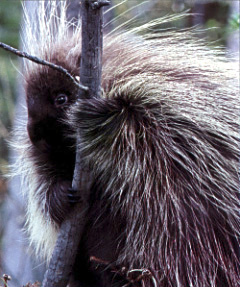Porcupine
Background
Information
The porcupine
is a slow-moving rodent. It lives in the
forest regions of Canada and the United States. Early settlers
hunted porcupine for its meat.
The only
known enemy of porcupines is the fisher.
A fisher is a weasel-type animal that hunts small animals
in trees at night. The fisher flips the porcupine onto its
back. Then, it attacks the unprotected chest and stomach of
the porcupine.
Many
people consider the porcupine a pest because it kills trees.
You will see why when you read about its food source. |
 |
Physical
Features
Porcupines
are furry animals that grow to be 2 or 3 feet in length. Their
tails can add up to a foot. Porcupines are well known for
their loose, sharp hairs called quills. The
porcupine’s quills cover all of its body except for
its chest and stomach. The porcupine protects most of its
body with about 30,000 quills. When danger is near, the quills
stick out. An animal that attacks a porcupine can end up with
a nose full of sharp, painful quills.
Their legs are short and their bodies are rounded. They have
padded feet and long sharp claws. Porcupines usually weigh
between 8 to 15 pounds. However, some males have weighed as
much as 40 pounds.
Life
Cycle
The male
porcupine lives alone. It looks for a mate in late fall. It
does not see well so it has to use its sharp senses of hearing
and smelling to find a mate. After mating, the female porcupine
forces the male to leave. After about 7 months, a baby porcupine
is born.
Young porcupines are fully developed at birth and can walk
at once. Their quills are soft, leaving them without protection.
They nurse for about a month. Then, they are expected to find
trees to climb because that is where their food can be found.
It takes up to four years for a porcupine to be fully grown.
Porcupines can live up to 17 years.
Habitat
Porcupines live in many places depending upon the season.
In spring, porcupines will fed on grass in meadows. During
summer, they will gnaw on tree roots and new tree shoots.
In the winter, their favorite place is in pine trees between
20 to 100 feet above the ground.
Porcupines spend most of daylight hours sleeping in dens
found in hollow logs or rocky places. They have several dens
in their areas. They do not travel too far from their dens.
Because of poor eyesight, they always use the same route from
the den. Porcupines make paths from their dens to their feeding
places.
Diet
Porcupines
love pine needles, pine bark, and the sap from pine trees.
(That is how they got their name!) As you have already read,
they will eat grasses and tree roots. Porcupines also eat
seeds, twigs, berries, and leaves. They are known as herbivores,
or plant eaters. Because porcupines love pine bark, they are
not popular animals with people in the logging business.
|